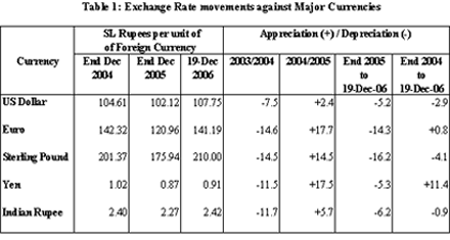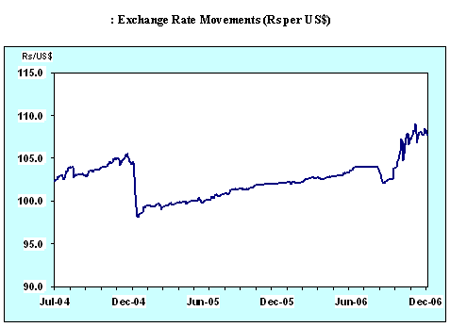| Average rate of change of the Exchange Rate (Rs per US$) | |
|
Period |
Appreciation (+)/ Depreciation (-) |
| Jan 1, 2001 - Dec. 31, 2004 | -5.9% |
| Jan 1, 2004 - Dec. 31, 2005 | +2.4% |
| Jan 1, 2005 - Dec. 19, 2006 | -5.2% |
| Jan 1, 2004 - Dec. 19, 2004 | -1.5% |
|
(Source: Central Bank of Sri Lanka) |
|
Despite a somewhat floating exchange rate, the bank has been busy in the past few months selling dollars to prevent the rupee from heading towards the 110.00 mark against the greenback.
The rupee is currently trading at around 107 to the dollar, while the central bank has spent around 400 million dollars since the start of this year to defend the currency.
The bank's economic research department, however, is not too alarmed saying the depreciation is 'normal' given the unusual appreciation in the earlier year due to unprecedented dollar inflows following the December 2004 tsunami, which killed about 31,000 people.
| Tsunami-related Direct and Indirect inflows during 2005 | |
|
Direct & indirect inflows |
US$ mn |
| Debt moratorium | 374.5 |
| IMF emergency assistance | 157.0 |
| Tsunami related inflows | 333.0 |
| Government - 185.0 mn | |
| NGOs - 148.0 mn | |
| Total | 864.5 |
|
Source: Central Bank of Sri Lanka |
|
Sri Lanka received an exceptional foreign currency inflows of around 490 million dollars in 2005, as well wishers and foreign aid donors offered to help rebuild the lives of around a million displaced people.
"In addition, international lenders offered a debt moratorium during 2005 as a result of which the country did not have to service external debt repayments amounting to approximately 374 million dollars," the bank said.
The International Monetary Fund (IMF) also chipped in with 157.0 million dollars, by way of emergency assistance and deferring their annual debt repayment from Sri Lanka.
Post-tsunami relief assistance saw the rupee sharply gain value against other major currencies, which also helped the country's balance of payments record a 501 million dollar surplus in 2005.
 |
The rupee, which was falling by an annual rate of 5.9 percent from 2001-2004, has now depreciated to 5.2 percent to date since January 1, 2006, the central bank said.
However, economists have pointed out that the Sri Lanka rupee is depreciating due an overvaluation of the real exchange rate arising from excessive domestic inflation compared to the country's trading partners, and massive money printing by the central bank to finance the budget deficit.
 |
At this week's treasury bill auction the central bank bought 8 billion rupees worth of treasury bills, largely renewing their own maturities and drove yields up by an average of 18 basis points.
